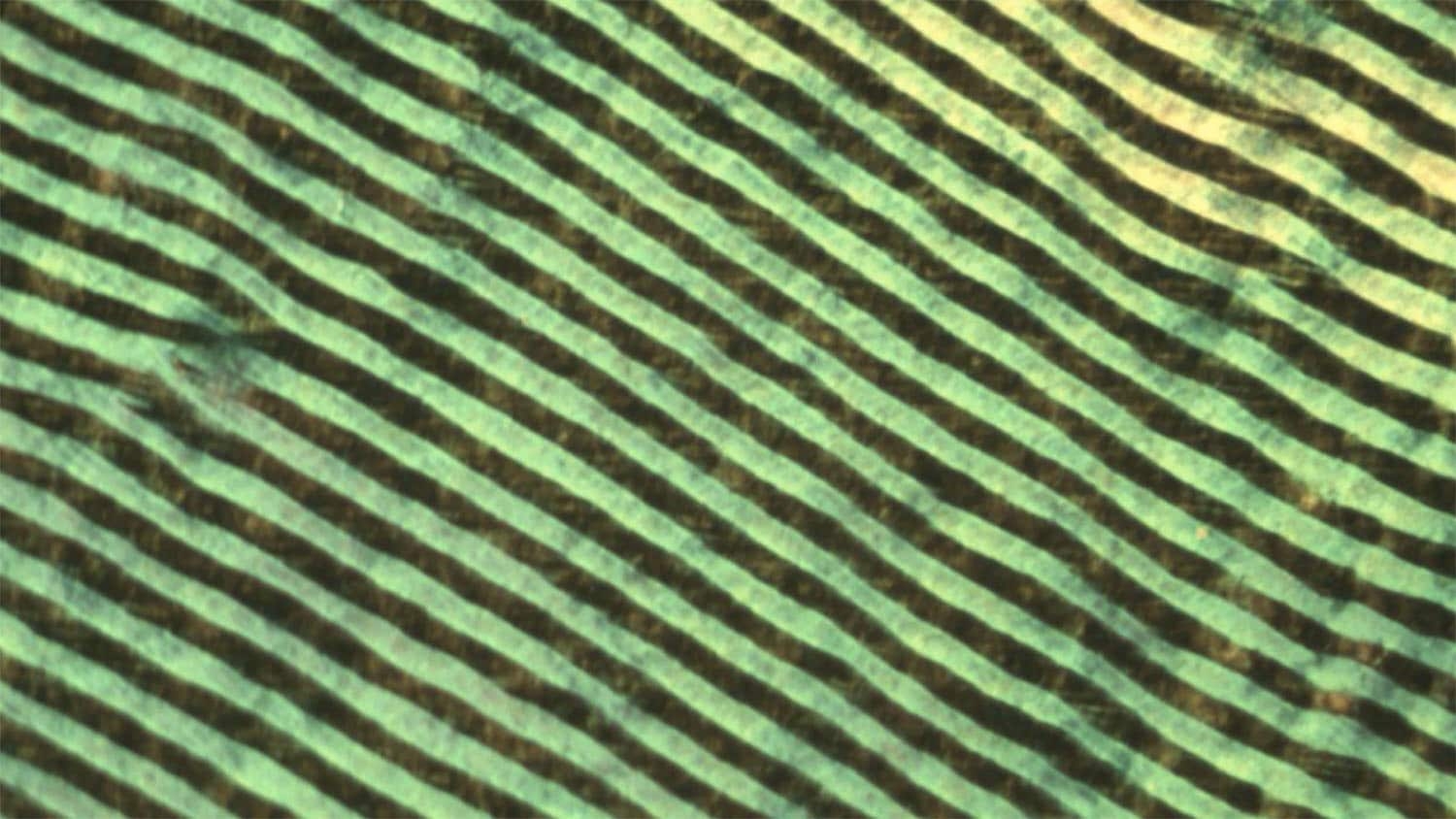Printed Polymer Allows Researchers to Explore Chirality and Spin Interactions at Room Temperature

For Immediate Release
A printable organic polymer that assembles into chiral structures when printed has enabled researchers to reliably measure the amount of charge produced in spin-to-charge conversion within a spintronic material at room temperature. The polymer’s tunable qualities and versatility make it desirable not only for less expensive, environmentally friendly, printable electronic applications, but also for use in understanding chirality and spin interactions more generally.
Spintronic devices are electronic devices that harness the spin of an electron, rather than its charge, to create energy-efficient current used for data storage, communication, and computing. Chiral materials refer to materials that cannot be imposed on their mirror image – think of your left and right hands, for example. If you lay your left hand over your right, the finger positions are reversed. That is chirality.
Chirality in spintronic materials allows designers to control the direction of spin within the material, known as the “chirality-induced spin selectivity (CISS)” effect. The CISS effect occurs when charge current flows along the chiral axis in a chiral material, producing spin – or charge-to-spin conversion – without needing ferromagnetic elements. Charge-to-spin conversion is necessary for memory storage in computing devices.
“We know that CISS-driven charge-to-spin conversion works efficiently in chiral semiconductors, but we want to know why,” says Dali Sun, associate professor of physics, member of the Organic and Carbon Electronics Lab (ORaCEL) at North Carolina State University and co-corresponding author of the work. “And an easy way to understand the puzzling mechanics of such a process is to reverse it, that is, to look at spin-to-charge conversion via the inverse CISS effect.”
Sun worked with Ying Diao, associate professor of chemical and biomolecular engineering at University of Illinois Urbana-Champaign and co-corresponding author of the work, who developed printing processes to assemble conjugate organic polymers into chiral helical structures.
“Organic materials can transport spin over long distances, but they aren’t good at converting spin to charge, which is necessary for spintronic devices,” Diao says. “By making the structure of this material chiral we can leverage it to convert between spin and charge.”
“The CISS effect is created by putting a charge into a chiral spintronic device, but figuring out how efficiently the charge is converted to spin within the device is very challenging because it is hard to measure the produced spin in a quantitative way,” Sun says.
“The inverse chirality-induced spin selectivity effect, or ICISS, where you put spin into the device and measure the resulting current, has not been studied in organic polymers,” Sun says. “But it’s a lot easier to measure current than spin. So that’s what we did.”
Sun used microwave excitation as a spin-pumping technique to inject pure spin into the organic polymer and measure the resulting current.
The researchers found that spin lifetimes up to nanoseconds were achievable in the chiral organic polymer at room temperature, as opposed to the picosecond lifetimes in traditional spintronic materials.
“The beauty of this material – among other things – is its tunability,” Sun says. “We can change chirality, conductivity, and see how that affects spin or efficiency. We now have a way to really gain insight into why CISS-related spintronic devices work, which could help us design better and more efficient ones.”
“Polymer-based electronics are much less energy-intensive to fabricate than current electronics, and are easy to scale up for production,” Diao says. “Since polymer semiconductors are printable – they can be printed in the same way newspapers are – they would be ideal for portable, flexible and stretchable applications ranging from solar cells to new forms of computers.”
The work appears in Nature Materials and is supported by Air Force Office of Scientific Research, Multidisciplinary University Research Initiatives (MURI) Program under award number FA9550-23-1-0311; the Department of Energy; the National Science Foundation; the Office of Naval Research and the U.S. Air Force. Rui Sun of ORaCEL and Kyung Sun Park of Urbana-Champaign are co-first authors. Andrew H. Comstock and Aeron McConnell of NC State; Yen-Chi Chen and Axel Hoffmann of University of Illinois Urbana-Champaign; Peng Zhang, and David Beratan of Duke University; Wei You of UNC-Chapel Hill; and Zhi-Gang Yu of Washington State University, also contributed to the work.
-peake-
Note to editors: An abstract follows
“Inverse Chirality-Induced Spin Selectivity Effect in Chiral Assemblies of π-Conjugated Polymers”
DOI: 10.1038/s41563-024-01838-8
Authors: Rui Sun, Andrew H. Comstock, Aeron McConnell, Dali Sun, North Carolina State University and ORaCEL; Yen-Chi Chen, Kyung Sun Park, Axel Hoffmann, Ying Diao, University of Illinois Urbana-Champaign; Peng Zhang, David Beratan, Duke University; Wei You, University of North Carolina Chapel Hill; Zhi-Gang Yu, Washington State University
Published: March 15, 2024 in Nature Materials
Abstract:
Coupling of spin and charge currents to structural chirality in non-magnetic materials, known as chirality-induced spin selectivity (CISS), is promising for application in spintronic devices at room temperature. Although the CISS effect has been identified in various chiral materials, its Onsager reciprocal process, the inverse CISS (ICISS) effect remains unexplored. Here we report the observation of the ICISS effect in chiral assemblies of π-conjugated polymers. Using spin-pumping techniques, the ICISS effect enables quantification of the magnitude of the CISS-driven longitudinal spin-to-charge conversion in different chiral polymers. By widely tuning conductivities and supramolecular chiral structures via a printing method, we found a very long spin relaxation time of up to several nanoseconds parallel to the chiral axis. Our demonstration of the ICISS effect opens possibilities for elucidating the puzzling interplay between spin and chirality, and opens a route for spintronic applications using printable chiral assemblies.
This post was originally published in NC State News.


